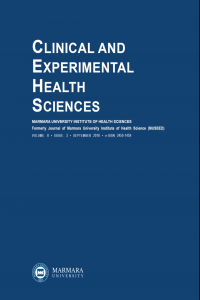Mast Cell Degranulation Mediates Compound 48/80-Induced Meningeal Vasodilatation Underlying Migraine Pain
Abstract
Objective: The cranial dura mater contains plenty of mast cells and is principally
supplied by the middle meningeal artery which has a key role in the generation of
headaches. Neurogenic inflammation caused by perivascular nerve activation and
dural vasodilation is held responsible for migraine pain. Dural mast cells contribute
neurogenic inflammation and migraine via vasoactive and proinflammatory mediators
in their secretory granules. In the present study, it was aimed to investigate vasoactive
effect of mast cell degranulating agent compound 48/80 induced dural mast cell
degranulation on the middle meningeal artery and its anterior and posterior branches.
Methods: Isolated skulls obtained from male Wistar rats were divided into 2 halves.
The skull cavities with intact the dura mater were applied synthetic interstitial fluid
for control group or mast cell degranulating agent compound 48/80 (10 μg/ml) in
synthetic interstitial fluid for treated group at 37 oC for 15 min. Diameters of middle
meningeal artery and its anterior and posterior branches were measured and mast
cells were counted from whole-mount preparations of meningeal dura mater.
Results: While compound 48/80 induced massive degranulation of dural mast cells
(P<0.01), it did not change the number of mast cells in the dura mater. Moreover,
compound 48/80 increased diameter of middle meningeal artery (P<0.01) and
its anterior (P<0.05) and posterior (P<0.01) branches, respectively compared to
synthetic interstitial fluid treatment.
Conclusion: Dural mast cell degranulation causes dilatation of middle meningeal
artery which is involved in the pathophysiology of migraine, therefore testing of mast
cell stabilizing agents in vivo models of migraine pain may promise hope for the next
big things in the treatment of migraine headaches.
References
- Moskowitz MA. The visceral organ brain Implications for the pathophysiology of vascular head pain. Neurology 1991; 41: 182-86.
Abstract
References
- Moskowitz MA. The visceral organ brain Implications for the pathophysiology of vascular head pain. Neurology 1991; 41: 182-86.
Details
| Primary Language | English |
|---|---|
| Journal Section | Articles |
| Authors | |
| Publication Date | September 28, 2018 |
| Submission Date | July 20, 2017 |
| Published in Issue | Year 2018 Volume: 8 Issue: 3 |


